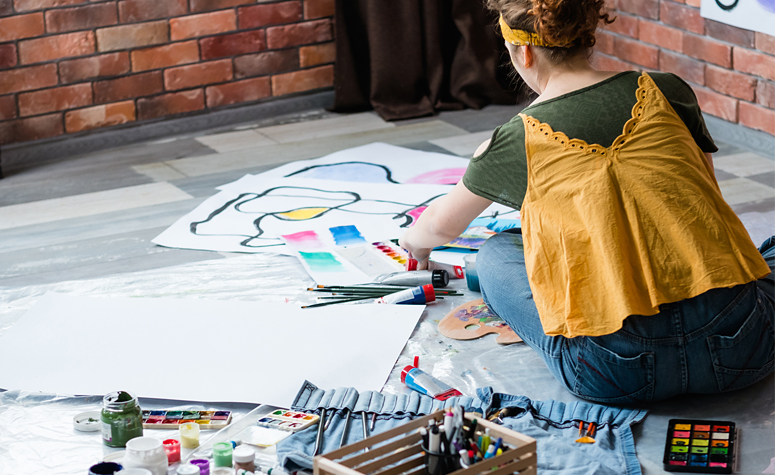Art Therapy Explained
In addiction treatment, there are also many alternative practices explored in conjunction with therapy, full detox, and counselling to achieve holistic recovery. One alternative is evidence-based art therapy, which has been instrumental in helping the recovery process. Read on to discover how art therapy works in addiction treatment.

What is Art Therapy?
According to the British Association of Art Therapists (BAAT), art therapy uses art media to communicate emotions. Art therapy allows people to express their feelings through art without verbalising it, which can be difficult for most people.
Art therapy is seen as a useful medium to help people struggling with addiction process raw emotions like grief, trauma, shame, or guilt that they otherwise might find difficult to express in the usual therapy setting.
For most people who may struggle to share in a group setting, the solo act of creating art can be a wonderful reprieve for them. Art therapy has many branches, and according to BAAT, this includes:
- Psycho-educational
- Mindfulness
- Mentalisation-based treatments
- Compassion-focused therapy
- Cognitive analytic therapy
- Socially engaged practice
Art therapy is just a blanket term for these practices, and this requires different kinds of instruction. As addiction may manifest differently from person to person, art therapy’s various forms can help people pick the treatment that resonates with them.
Types of art therapy
There are many types of art therapy, and they don’t only start and end with drawing or painting. Sculpting, poetry, dance, and other artistic forms are also seen as practices for expression.
However, drawing and painting are the main kinds of art therapy because of their simplicity and accessibility for most people. Since not all people have a penchant for the arts, accessibility is a leading factor to be considered.
Below are the three main art therapy approaches:

- Gestalt – This is the typical approach where the individual attempts to create art to reflect their current emotions. Their art becomes a starting point for therapists to ask questions and discuss their thoughts.
- Active Imagination – With this method, there is no expression of emotions involved like Gestalt. Instead, it’s more of a stream of consciousness where they paint or draw whatever comes to mind. The therapist then explores more questions connected to the artwork they are creating and their underlying emotions.
- Third Hand – This kind of art therapy requires the therapist as the “third hand” of the person. They direct what should be drawn or painted and are often used for patients who don’t feel confident in creating art or have no idea where to start to express their emotions through art.
- Incident Drawings – In this method, the patient tries to recollect the incidents in their life leading up to their addiction or during that period. This helps them process their firsthand experiences more.
Other types of art therapy are stress painting to let out stress, art journaling, where they mix different kinds of media, and sculpting to express their emotions or whatever is on their mind.
What Happens in a Typical Art Therapy Session?
Art therapy differs from person to person as they can take various avenues to create art. However, the typical art therapy session has some structure across all types.
The first requirement is that a professional art therapist should be present to facilitate the session. It’s crucial that a therapist is knowledgeable in different scientific areas like psychology and art to be qualified.
Art therapy is then facilitated in a group setting and lasts an hour or more. The session then starts with a brief discussion on how the different kinds of art therapy help each of them. This way, they can choose what kind of art technique they will pursue.
When the artwork is completed, the therapist will then ask specific questions to uncover discussions that help each individual. Here are just some of them:
- What message or feelings were you trying to convey in your art?
- What name would you give to your art?
- Did you feel new emotions and feelings come up while you were
creating your art? If yes, what are they? - Were there new thoughts about your addiction and recovery that
came up when you were creating your artwork? - Were you thinking of some specific memories, incidents or life
experiences while you were making art?
In group settings, the participants can discuss with each other as well. This gives a more nuanced approach to its therapeutic side.
Once the session ends, the art therapist will collect most of the artwork for safekeeping. Their artworks will be then given to them after they finish their addiction treatment if they choose to do so, and most people usually keep them.

What lies behind us and what lies before us are
tiny matters compared to what lies within us
What Scientific Evidence is there for Art Therapy?
There have been many studies conducted to examine the positive impact of art therapy on addiction treatment. A consensus from scientific groups has concluded how it is helpful in addiction recovery.
In fact, because of art therapy’s positive findings, over 36.8% of addiction programmes incorporate it as opposed to other alternative treatments like acupuncture (only 8.8%) and hypnotherapy (only 3.3%).
Another study by Cox and Price shares that art therapy can help dissolve denial for most people, especially those who have used the substance during their adolescence.
Another study by Donna H. Kaiser and Elizabeth Holt found that art therapy encourages patients to create positive life changes.
Because of these discoveries, it’s no surprise that art therapy has become more prevalent in addiction treatment to promote recovery.
What are the benefits of art therapy?
Art therapy’s benefits go far from the mere expression of emotions. Here’s a list breaking down the groundbreaking benefits of art therapy when included in addiction treatment:
- Helps patients articulate their emotions, especially if they find it hard to open up about their experiences with a therapist.
- Allows patients to process feelings like shame, guilt, anger, and fear.
- Creates an avenue and opportunity for the patient to discover or rediscover their artistic side.
- Creates a sense of achievement and pride for the patients, which can ultimately help them move forward with their recovery positively.
- Helps the therapist understand the patient’s emotional state through their artwork as opposed to the usual talk therapy sessions.
- Allows patients to have an avenue to express themselves in creative ways without the fear of judgment freely.
- Gives a calming effect to patients, as reported by recovering people with an addiction, and can be used as an activity during stressful situations or when unpleasant feelings come up.
- Gives patients the opportunity to practice a skill outside treatment and can be another tool they can use to protect them from relapse.
Art Therapy as a Form of Group Therapy
Most art therapy sessions happen in groups as this promotes connections among the recovering patients. While some may feel averse to sharing their emotions in a group session, this can also become a supportive community for them as they are encouraged to connect and share more of their struggles and feelings.
Alison Hawtin, a renowned art therapist, shared that art therapy can offer a different experience for those suffering from addiction because of the group’s unique dynamics as opposed to the usual one-on-one sessions.
For a community to become supportive, the critical point is the knowledge that all of them are experiencing the same thing together and have the same goal: recovery. Their experiences may differ from person to person, but a sense of solidarity can be fostered thanks to the “unique dynamic” that this setting offers.

How is Art Therapy Incorporated into Addiction Treatment?
Art therapy is done in conjunction with addiction treatment that usually includes a full detox, therapy, counselling, etc. It should not be done as the sole treatment option but as a complementary addition.
The benefits of art therapy can be very profound, especially when the individual has gone through a detox already and is receiving talk therapy or group counselling. Alongside this, art therapy’s main role is to help uncover repressed or difficult emotions that are heavily tied to their addiction. This way, the overall treatment’s impact has far more significant benefits for the patient’s holistic recovery and protects them from a possible relapse.
Addiction often has underlying mental health issues, too, like anxiety, depression, or post-traumatic stress disorder (PTSD). Art therapy can help uncover these issues, especially when individuals struggle to articulate their inner world through words.
Facts and Statistics About Art Therapy
- Art therapy was discovered around the 1940’s and was largely attributed to the work of Margaret Naumberg in the US.
- Art therapy is beneficial not only for addiction treatment but also in dealing with other mental health issues.
- Art therapy is not limited to one medium only but covers a whole variety of mediums for artistic expression.
- Art therapy was found to help in reducing violent incidents in prisons and also the possibility of relapse of criminal activities from convicted criminals.
FREE Addiction Assessment
If your or a loved one are struggling with addiction, we understand the challenges you’re facing and we’re here to offer compassionate help.
Our highly trained advisers are available to speak to you right away, simply call 0808 252 3379 today.
We can discuss your concerns in complete confidence, explore the options for treatment, and help you to understand what will work best for you.
We’ll also help you to book your free addiction assessment there and then, with appointments usually available within only a few days.
We understand that taking the first step can be the most difficult, but we’re here to support – with no pressure or judgement.
Professional and compassionate help is just a phone call or click away.




